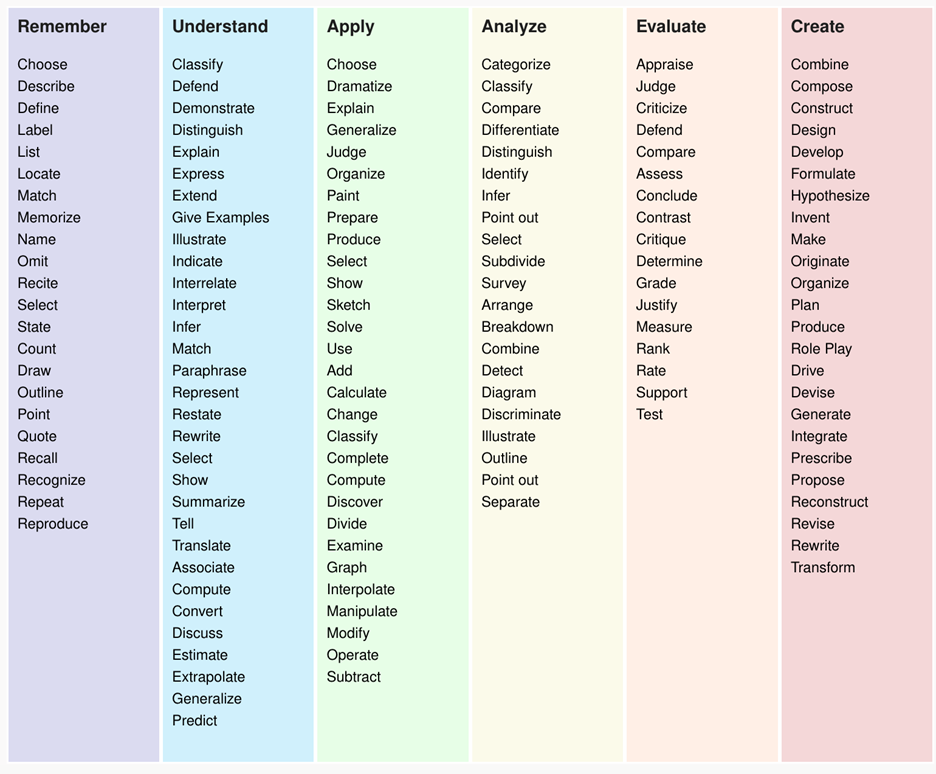Writing Measurable Learning Outcomes
In the course design process, consider starting at the end and designing backwards. Whether you’re designing a course from scratch or retooling an existing course, measurable learning outcomes and objectives can help you chart a clear path for you and your students.
Defining Terms:
- Learning Outcomes – What you want your students to know at the end of the semester. Think of these as a course goals.
- Learning Objectives – Individual units of knowledge/skills students will use as building blocks towards those outcomes. Think of these as individual activities, assignments, or deliverables.
Learning outcomes should be worded to include:
- A strong action verb
- A learning outcome statement specifying the learning that will take place
- A broad statement reflecting the criterion or standard for acceptable performance
See the table below for examples:
| Action Verb | Learning Outcome Statement | Criterion |
|---|---|---|
| The student will be able to apply | knowledge of mathematics, science and engineering principles | in addressing aerospace engineering problems. |
| The student will be able to apply | knowledge of the scientific method | to develop reasoned solutions to address environmental problems. |
| The student will be able to demonstrate | knowledge of contemporary issues | that impact the field of business. |
Adapted from Georgia Tech’s Office of Academic Effectiveness: https://academiceffectiveness.gatech.edu/assessment-toolkit/developing-student-learning-outcome-statements/#writing
This quick 3-minute video on learning objectives from Virginia Apgar Academy of Medical Educators explains these concepts efficiently: https://www.youtube.com/watch?v=vfBR8qggpY0
Bloom’s Taxonomy as a Framework for Writing Learning Objectives
Developing a basic understanding of Bloom’s Taxonomy (Bloom et al., 1956) is a good place to start as you begin writing learning objectives.
Bloom’s Taxonomy in a nutshell: In the late 1940s a group of educators began classifying educational goals and objectives. The intent was to develop a classification system for three domains: the cognitive (mental skills or knowledge), the affective (feelings and emotional skills or attitude), and the psychomotor (manual or physical skills). The work that resulted in the cognitive domain was completed in 1956 and is commonly referred to as Bloom’s Taxonomy of the Cognitive Domain (Bloom et al., 1956).
The major concept of the taxonomy is that educational objectives can be arranged in a hierarchy that moves from less to more complex levels of knowledge. The levels are successive; one level must be mastered before the next level can be reached.
The original levels published by Bloom et al. (1956) were ordered as follows: Knowledge, Comprehension, Application, Analysis, Synthesis, and Evaluation.
In 2001 Anderson and Krathwohl published a revised version of Bloom’s Taxonomy that reflected what has been learned in the forty or so years since it was first published. In summary, the changes reflect more outcome-focused modern education objectives and include switching the names of the levels from nouns to active verbs. The two highest levels have also been changed with the pinnacle level now being ‘create’. The revised levels are: Remember, Understand, Apply, Analyze, Evaluate and Create. View CELT’s Revised Bloom’s Taxonomy page.
Applying Bloom’s Taxonomy to Learning Objectives
Effective learning objectives need to be observable and/or measurable, and using action verbs is a way to achieve this. Verbs such as “identify”, “argue,” or “construct” are more measurable than vague or passive verbs such as “understand” or “be aware of”. As you design your course focus on creating clear learning objectives and then use these objectives to guide class assignments, exams, and overall course assessment questions.
Action Verbs
Below are examples of action verbs associated with each level of the Revised Bloom’s Taxonomy. These are useful in writing learning objectives, assignment objectives, and exam questions.

This entire section is copied and pasted from Iowa State University’s Center for Excellence in Learning and Teaching website, so we’ll need to figure out how to cite this appropriately. https://www.celt.iastate.edu/instructional-strategies/preparing-to-teach/tips-on-writing-course-goalslearning-outcomes-and-measureable-learning-objectives/

Download Bloom’s Digital Taxonomy for free!
This 10-minute video from John’s Hopkins University provides a history and overview of Bloom’s Taxonomy and gives some insight into how to use this taxonomy in course design, including the process of writing learning outcomes and objectives. https://www.youtube.com/watch?v=nq0Ou1li_p0
Checklist for Writing Effective Learning Outcomes:
- Does the outcome describe what you intend for students to know (cognitive), think (affective, attitudinal), or do (behavioral, performance)?
- Is the outcome a result of learning?
- Does the outcome start with an action verb?
- Is that verb followed by a learning outcome statement and a broader statement of the criteria for acceptable performance? (See examples above.)
- Does your course contain an activity or deliverable that allows students to learn and demonstrate the desired outcome? (If not, how could you create one?)
- Does this outcome support the program goals? Can the results from assessing this outcome be used to make decisions on how to improve the program?
Adapted from Georgia Tech’s Office of Academic Effectiveness: https://academiceffectiveness.gatech.edu/assessment-toolkit/developing-student-learning-outcome-statements/#writing
The University of Nevada, Reno has developed a Learning Outcomes Generator that could help to get you started!